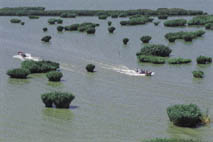|
Desert Eco-tourism
 |
|
Ningxia's Shahu Tourist Area is a natural ecological zone of lakes, marshes and sand dunes. |
Shapotou is located on the southeastern edge of the Tengger Desert, 20 kilometers west of Zhongwei City. At the United Nations Conference on Desertification held in Nairobi in 1977, a photo presented by the Chinese delegate highlighted Shapotou's achievement in fighting desertification by planting sand plants and installing straw grids. Shapotou's experience has been called a "miracle."
In 1958, the Baotou-Lanzhou Railway, a trunk railway linking Beijing with northwest China, was put into operation. It passed through desert six times within the boundary of Zhongwei, and the sandstorms in Shapotou were the fiercest. Now 100-meter-wide straw grids, using 5 million kilos of straw and covering 16,000 mu of land, guard both sides of the track. After decades of effort by the Chinese Academy of Sciences and the Ministry of Forestry, no breakdown of the railway has occurred in recent times because of sandstorms.
Ningxia has achieved a breakthrough in fighting desertification by installing straw grids and growing drought-resistant plants inside. More and more desert highways have been constructed as a result, and more and more sand dunes have been covered by plants. The arid land has been reduced from 1.65 million hectares in the early 1980s to 1 million hectares at present. Every now and then, a train drops off visitors at the Shapotou Sand Control Museum, and many remark that they cannot reconcile the bare land shown in the old photographs on display with the flourishing scene outside.
At present, Shapotou is famous among tourists for its desert tours. In this national 5A scenic area, tourists can ride desert surfing vehicles, go sand tobogganing and bungee jumping, or take sheepskin raft trips down the Yellow River.
Tong Facai, a farmer from Shapotou Village, is now a boatman in the scenic area. The seven months from April to October are the busy tourist season, and no farmer in his village engages in agriculture any more. Except for those who go to other areas as migrant workers, most of the villagers work in the scenic area.
Tong earns RMB 2,000 a month, and his wife has an annual income of RMB 10,000 from photography. Their 18-year-old daughter is enrolled in a university in Kunming, and their son wants to join the army. Tong says that when he was young, Shapotou was "primitive." There was nothing but sandy wasteland. Now, the environment of the village and people's living standards have improved remarkably.
The Shapotou Tourist Area receives more than 1 million tourists a year, and the annual income from tourism exceeds RMB 200 million. The Shahu Tourist Area at Shizuishan, now similarly well known, has an annual income of RMB 100 million. According to a local official, the incomes from desert eco-tourism can be used to plant more trees and fight desertification. |
